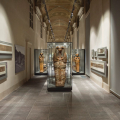It is simply the second richest museum of Egyptian antiquities in the world after the one in Cairo. Not to be missed!
After Cairo, it is the second most important Egyptian museum in the world. Housed in a 17th century palace, a former Jesuit college, the Academy of Sciences was established as a museum in 1724 by the Savoys. It was enriched by King Charles-Felix of Savoy who bought in 1824 the collections of the French Consul General in Egypt, Bernardino Drovetti. After five years of titanic work that doubled the exhibition space, the museum presents more than 3,500 pieces on 10,000m2.
Hypogeum. After the ticket office and the store, the visit begins on the mezzanine floor, where the first section dedicated to the history of the museum opens. The Papyrus of Iuefankh (4th century B.C.), one of the longest books of the dead in the world, is nearly 18 meters long.
The Great Nile. Amazing bluish escalators, flowing like the waters of the Nile, lead us to the second floor. It is a real work of contemporary art, designed by Dante Ferretti, the famous set designer, author of the sets of many films(The Name of the Rose, Aviator).
Second floor. The journey begins around 4,000 BC. A mummy, the oldest in the collection, is crouched in an oval pit, curled up on itself. It is still far from the later sumptuous burials. Large showcases display relics from the Predynastic period. The frescoes on the Tomb of Iti and Neferu present scenes of the daily life of the Egyptians.
Second floor. After having crossed a curious papyrothèque (more than 2 km of papyrus!), the Gallery of the Sarcophagi opens to us. An alignment of chests painted in bright colors stands in the windows. Another room exhibits the treasures found during the excavations of the village Deir-el-Medina: the marvelous chapel of the Tomb of the painter Maia and Tamit with astonishing wall paintings as well as theOstrakon with the dancer . Of a breathtaking realism, this probable artist's sketch is very different from the official paintings with strictly regulated iconography.
The collection of mummies, including those of numerous animals, cats, dogs and crocodiles, is moving, as is the mummy of the child Petamenofi, which has made it possible to reconstruct his entire family, now "scattered" in museums throughout Europe.
Tomb of Ka. In the most prestigious room of the museum sits the tomb of Ka, court architect of the pharaoh Amenhotep III, and that of his wife Merit (1400 BC). Perfectly intact, it arrived in Turin at the beginning of the twentieth century with its funerary trousseau: beds and sarcophagi, the Book of the Dead, board games, a toilet box, Merit's wig, linen tunics and even fossilized food.
First floor. The monumental staircase descends to the Gallery of the Kings, whose Hollywood scenography by Dante Ferretti impresses. The visitor wanders in the middle of a "glorious assembly of kings and deities" according to the words of Champollion. Among the statues, that of Ramses II in black basanite and that of Sethi II (more than 5 m high).
The rock temple of Ellesija (1430 BC) saved from the waters in the 1960s just before the construction of the artificial lake of Nasser and the dam of Assuan. As a thank you for helping to save the entire Abu Simbel region, the Egyptian authorities offered the oldest temple in Nubia to the Turinese.
Did you know? This review was written by our professional authors.
Members' reviews on EGYPTIAN MUSEUM
The ratings and reviews below reflect the subjective opinions of members and not the opinion of The Little Witty.




